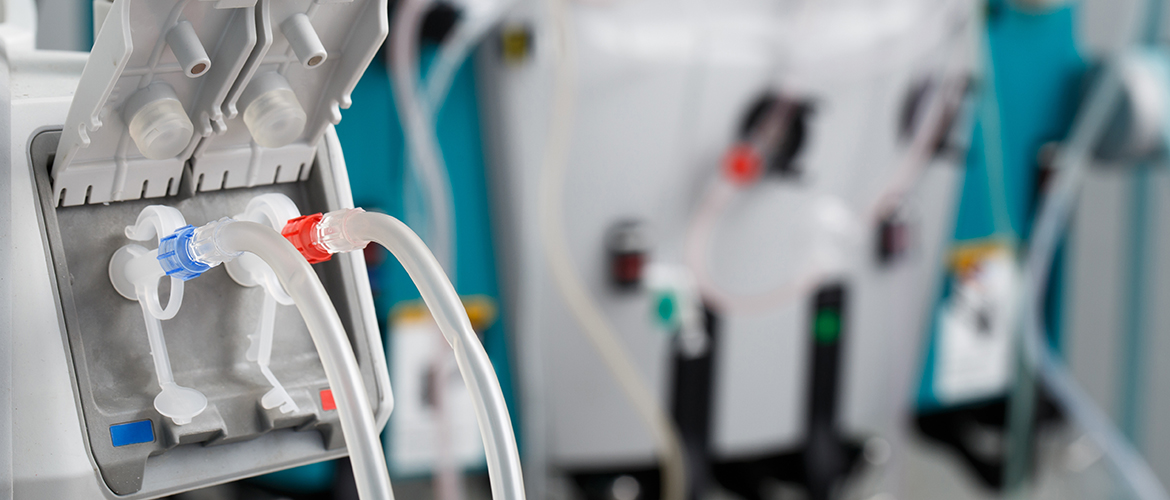Flipping the Script on Kidney Failure
Oct. 24, 2019
Four hours, three times a week, for the rest of their lives.
That’s the routine for people on hemodialysis after their kidneys fail. A machine — usually in a dialysis center — does what the organs can’t anymore, filtering waste and excess fluid from the blood.
For people in end-stage renal disease, dialysis keeps them alive. But it’s a time-consuming, physically draining and expensive treatment.
And it can be avoided by catching and preventing chronic kidney disease (CKD), when kidneys are suffering permanent damage from other health conditions.
Federal health officials have identified CKD and dialysis as an area of the U.S. health care system that needs bold and innovative improvement.
In July, President Donald Trump signed an executive order to improve treatment and prevention and promote home dialysis and kidney transplants for people in Medicare.
Private insurers also have an opportunity to improve the experience and health outcomes for people who need dialysis — and for people whose health conditions indicate dialysis may be in their future.
Keeping kidneys functional
Kidneys don’t fail out of nowhere. Patients first progress through the five stages of CKD as their kidneys become less and less effective. Uncontrolled diabetes, high blood pressure and heart disease are the most common causes of CKD.
But kidney disease doesn’t have to lead to kidney failure.
“I would sometimes tell my patients, ‘I hope you die with a functioning kidney!’ Because that would be a success. They never needed to replace kidney function,” says Dr. Matthew Smith, a nephrologist and medical director with the Blue Cross and Blue Shield Plans in Illinois, Montana, New Mexico, Oklahoma and Texas.
CKD can be a complication related to diabetes, and claims data from Blue Cross and Blue Shield of Texas (BCBSTX) showed many members with diabetes were developing CKD.
In response, BCBSTX donated to charities that help screen for early signs of CKD and educate patients on what to do to prevent kidney failure as part of its Healthy Kids, Healthy Families initiative.
Over the last two years, BCBSTX gave over $3 million to eight nonprofits to bolster their work preventing kidney failure.
Some of the nonprofits perform urine tests to catch early signs of kidney failure. Others run a health coach help line, calling patients who show potential for kidney disease to help them manage their condition.
“We developed a focused strategy to support organizations across the state who are already doing this type of work in the community,” says Sheena Payne, director of community affairs for BCBSTX.
And the strategy proved successful. Total medical spending for members with CKD in counties with outreach events decreased $103 per member per month compared with members with CKD in counties without outreach events.
“We knew that this was the right thing to do for this health epidemic in Texas,” says Payne. “What we do in the community is for everyone. Our members benefit from it, but so does the community at large.”
Changing incentives
If kidneys lose too much of their function, patients and their doctors must choose if dialysis or a kidney transplant is right for them.
Currently, 661,000 Americans are in kidney failure. Of them, 193,000 live with a functioning kidney transplant — the rest are on dialysis.
Medicare covers the cost of dialysis for everyone who needs it, even if they’re under age 65. Private insurance companies cover dialysis for 30 months until the member transitions to Medicare. BCBSTX has 2,411 members on dialysis
It’s expensive for the government program. Medicare beneficiaries with kidney failure make up about 1% of total enrollment but account for 7% of total spending.
In the U.S., most dialysis patients choose outpatient hemodialysis. Smith likens this type of dialysis as going to a full-service gas station. Patients just show up and the work is done for them. They come to a dialysis center three times each week to have their blood pumped through a filtering machine for about four hours.
Patients could also choose in-home hemodialysis. This is the same type as in-center hemodialysis but done with a smaller machine in the patient’s home.
Nearly all of Americans — and over half of BCBSTX members — on dialysis do it in a center.
In the rest of the world, that’s not the case. Instead, a different approach — called peritoneal dialysis — is much more common. A cleaning fluid is injected daily into the abdominal cavity and then drained.
Peritoneal dialysis costs much less per visit and is typically performed at home. But it has failed to gain traction in the U.S., in part because of how the health care system functions.
“The incentive is there to fill as many chairs as you can in a center,” Smith says. “We need to make the financial incentives line up so we’re like the rest of the world doing it better and less expensive in the home.”
Paying doctors to spend time educating patients on home dialysis options is one way to change incentives.
The Centers for Medicare and Medicaid Services is attempting to do that. Its ESRD Treatment Choices Model, announced in July, would pay doctors to educate patients on their treatment options.
“I think it can be done,” Smith says of shifting patient choice to less-expensive, in-home dialysis options. “It just needs resources, so people don’t feel abandoned and like they don’t have the support they need.”
Shifting the incentives, providing the right resources and even preventing kidney failure to begin with can help patients avoid seeing the dialysis center for four hours, three times a week, for the rest of their lives.

